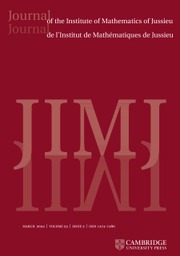Article contents
Réalisation de Hodge du polylogarithme d'un schéma abélien
Published online by Cambridge University Press: 20 November 2008
Abstract
In this article we show that the polylogarithmic currents introduced by Andrey Levin describe the polylogarithm of an abelian scheme at the topological level. From this result, which had been conjectured by Andrey Levin himself, we deduce a method to explicit the Eisenstein classes of abelian schemes at the topological level. These classes are of special interest since they have a motivic origin by a result of Guido Kings. In a forthcoming work entitled ‘Les classes d'Eisenstein des variétés de Hilbert–Blumenthal’, the results of the present article are used to prove that the Eisenstein classes of Hilbert–Blumenthal varieties degenerate at the boundary of the Baily–Borel compactification of the base in a special value of an L-function associated to the underlying totally real number field, and we get as a corollary a non-vanishing result for some of these Eisenstein classes in this geometric situation.
Résumé
Dans cet article, on démontre que les courants polylogarithmiques introduits par Andrey Levin décrivent le polylogarithme d'un schéma abélien au niveau topologique. De ce résultat, qu'Andrey Levin avait lui-même conjecturé, on déduit une méthode pour déterminer explicitement les classes d'Eisenstein des schémas abéliens au niveau topologique. Ces classes ont un intérêt particulier, car, comme Guido Kings l'a établi, elles ont une origine motivique. Dans une suite à ce travail intitulée «Les classes d'Eisenstein des variétés de Hilbert–Blumenthal», on utilise les résultats obtenus dans le présent article pour démontrer que les classes d'Eisenstein des variétés de Hilbert–Blumenthal dégénèrent au bord de la compactification de Baily–Borel de la base en une valeur spéciale de fonction L associée au corps de nombres totalement réel sous-jacent, et on en déduit, dans ce contexte géométrique, un résultat de non annulation pour certaines classes d'Eisenstein.
Information
- Type
- Research Article
- Information
- Copyright
- Copyright © Cambridge University Press 2008
References
Références
- 4
- Cited by

